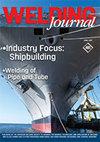Deep Learning-Based Detection of Penetration from Weld Pool Reflection Images
IF 1.4
3区 材料科学
Q2 METALLURGY & METALLURGICAL ENGINEERING
引用次数: 26
Abstract
An innovative method was proposed to determine weld joint penetration using machine learning techniques. In our approach, the dot-structured laser images reflected from an oscillating weld pool surface were captured. Experienced welders typically evaluate the weld penetration status based on this reflected laser pattern. To overcome the challenges in identifying features and accurately processing the images using conventional machine vision algorithms, we proposed the use the raw images without any processing as the input to a convolutional neural network (CNN). The labels needed to train the CNN were the measured weld penetration states, obtained from the images on the backside of the workpiece as a set of discrete weld penetration categories. The raw data, images, and penetration state were generated from extensive experiments using an automated robotic gas tungsten arc welding process. Data augmentation was performed to enhance the robustness of the trained network, which led to 270,000 training examples, 45,000 validation examples, and 45,000 test examples. A six-layer convolutional neural network trained with a modified mini-batch gradient descent method led to a final testing accuracy of 90.7%. A voting mechanism based on three continuous images increased the classification accuracy to 97.6%.基于深度学习的熔池反射图像侵彻检测
提出了一种利用机器学习技术确定焊缝熔透的新方法。在我们的方法中,捕获了从振荡熔池表面反射的点结构激光图像。经验丰富的焊工通常根据这种反射激光图案来评估焊缝的渗透状态。为了克服传统机器视觉算法在识别特征和准确处理图像方面的挑战,我们提出使用未经任何处理的原始图像作为卷积神经网络(CNN)的输入。训练CNN所需的标签是测量的焊透状态,从工件背面的图像中获得,作为一组离散的焊透类别。原始数据、图像和熔透状态是通过自动化机器人气体钨极弧焊工艺进行的大量实验生成的。执行数据增强以增强训练网络的鲁棒性,这导致270,000个训练示例,45,000个验证示例和45,000个测试示例。采用改进的小批量梯度下降法训练的六层卷积神经网络,最终测试准确率达到90.7%。基于三张连续图像的投票机制将分类准确率提高到97.6%。
本文章由计算机程序翻译,如有差异,请以英文原文为准。
求助全文
约1分钟内获得全文
求助全文
来源期刊

Welding Journal
工程技术-冶金工程
CiteScore
3.00
自引率
0.00%
发文量
23
审稿时长
3 months
期刊介绍:
The Welding Journal has been published continually since 1922 — an unmatched link to all issues and advancements concerning metal fabrication and construction.
Each month the Welding Journal delivers news of the welding and metal fabricating industry. Stay informed on the latest products, trends, technology and events via in-depth articles, full-color photos and illustrations, and timely, cost-saving advice. Also featured are articles and supplements on related activities, such as testing and inspection, maintenance and repair, design, training, personal safety, and brazing and soldering.
 求助内容:
求助内容: 应助结果提醒方式:
应助结果提醒方式:


